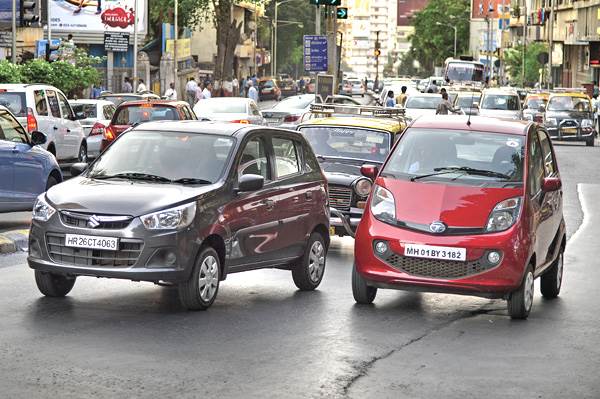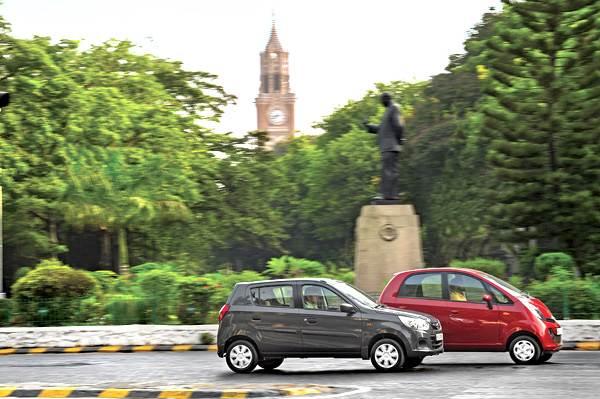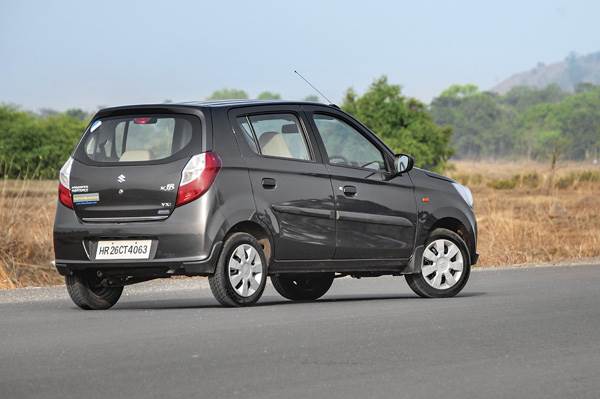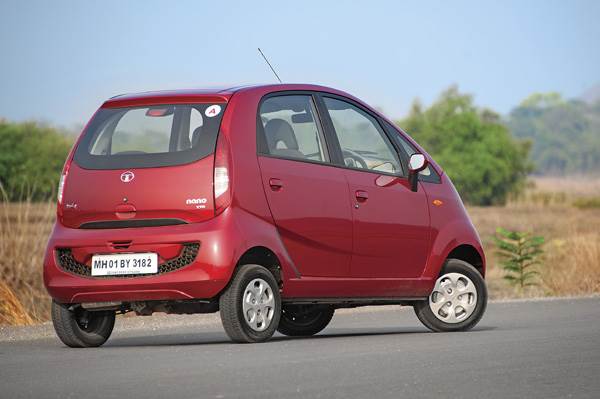Did you ever think you’d see the day when two of India’s (and the world’s) cheapest cars would be available with an automatic gearbox? We didn’t either. But here we are today, and thanks to the cost-effective goodness of the Automated Manual Transmission (AMT), you no longer have to burn a hole in your pocket to save your clutch from burning out. When Maruti introduced an AMT in the Celerio, we had a feeling it was only a matter of time before the smaller Alto — which uses the same K10 petrol engine — was given the same treatment. Tata, on the other hand, showcased at the 2014 Auto Expo a life-size cutaway of a Nano dashboard with an auto gearlever mounted to it, so the writing was on the wall from way back then.
Normally, we would have compared a Nano to the cheaper Alto 800, but since Maruti doesn’t offer the AMT with that engine, it has to be the 1.0-litre Alto K10 that we consider. But don’t for a moment think the Nano is the knife in this proverbial gunfight. Apart from the two-pedal layout, it’s also been given a facelift, which has made it a lot more attractive, a bigger 24-litre fuel tank, and, finally, a hatch that you can open. So it’s a lot more practical than before, and consequently, a fair bit more expensive too; more closely matched than it seems, then.
Short and tall
To look at, these two cars couldn’t be more different from one another, and neither is what you’d call attractive; if you think that’s because of the cost they’re built to, allow me to point you in the direction of the Hyundai Eon.
Despite this ‘GenX’ Nano’s aggressive new front and rear bumpers with their ‘Humanity Line’ grilles with infinity symbols in the mesh, and the blackened headlamp enclosures, it’s hard to dissociate it from the bug-eyed cutesy looks of the original, and that won’t be to everyone’s taste. And while the tall, monovolume shape does allow it a lot of interior space in a small footprint, it doesn’t do wonders for the car’s proportions, and neither do the tiny, 12-inch wheels. Though it may be more upmarket and user-friendly now, the Nano’s shape is a constant and immediate reminder of its unconventional and radical design. Just as unconventional as its rear-engine, rear-wheel-drive layout, which makes it the only car with this configuration in the country. Well, if you don’t include the Porsche 911.
The Alto K10, on the other hand, is far more conventional in its proportions, with a proper, two-box profile and a transverse engine driving the front wheels. First impressions show (surprisingly) that it’s the more expensive Alto that has more signs of being built to a cost, notably in its upright sides and rear. The Alto’s body panels do have a lot more sculpture to them than the Nano’s, and the headlamps and tail-lamps are a lot more detailed. But here too, it’s a mismatch of shapes and angles that don’t quite gel together properly.
It’s the tall Nano that’s far more visible in a crowd, but standing out is not really the reason you’d buy one of these, right? You buy one of these because you want an inexpensive city car that’s easy to use.
The perch
The Nano’s driving seat really is a perch, actually, and you access it by swinging open the tall, slim door and almost walking inside. You’re sat high and quite upright in the slim and narrow seat, but what it gives you is a superb view out of the front and sides. The only annoyance is the centrally placed instrument cluster that sticks up out of the dashboard and can cause a bit of a blind spot. In front of you is a new steering wheel which has been borrowed from the Zest, but without any audio controls on it. Unfortunately, Tata hasn’t addressed the steering position, which feels too low in relation to the seat height.
Also seemingly borrowed from the Zest are the stalks, which are of a very high quality. In fact, cabin quality has taken a huge step up from the Nanos of old, and worth a particular mention is the gear lever (again from the Zest), which sits on a tall pedestal along with the window switches, for much better ergonomics.

Neither car has a lot of in-cabin storage spaces, but the Alto just edges ahead. Both cars have very slim door pockets at the front, and the Nano has a pair at the rear where the Alto doesn’t. But then, the Alto has a neat cubbyhole behind the gearlever that’s good for your mobile phone. It also has a conventional glovebox. The Tata has its pair of covered cubbyholes on the dash, but they really can’t hold a whole lot. Also, it would have been more convenient to have left one of the cubbyholes uncovered for easy access to your stuff.
The Alto’s interior quality is on par with the Nano’s and feels a touch more consistent. It too has pretty good visibility out the front, but it’s nowhere near the commanding view you get from the Nano’s seat. The dash is full of interesting contours and has a nice piano-black finish for the integrated audio system. The Nano’s audio system is also a unique design and is well-integrated, and while both cars feature a CD player, USB and aux input, the Tata adds Bluetooth phone and streaming as well as two rear speakers (the Alto just has two in the front). And while the Maruti may score one over the Nano with a tachometer in its attractive instrument cluster, the Tata does have a more informative trip computer, which also gives you a real-time fuel consumption gauge. Since these are likely to be the first automatic car for a lot of buyers, both have thoughtfully included a sticker with handy instructions on how to drive without a third pedal!
Family room
Yes, these being automatics, they target those who drive themselves, but that doesn’t mean there won’t be family and friends along for the ride every now and then. These are both super-compact cars, so room at the back is understandably limited, but amazingly, you will find more space and in the diminutive Nano than some bigger cars. It scores particularly well for its size on head and legroom whilst even shoulder room is better than the Alto. You also get a flatter floor than in the Maruti, so that makes it better-suited to three passengers. Its tall seats and wide-opening doors also make ingress and egress much easier.
The Maruti is tolerable at the rear for short trips, but we’d say it’s better suited to two than three. Cabin width is not a strong point, and though the backs of the front seats are scooped out for better kneeroom, your shins will still brush against the base of the seats.

As with the front seats, the Nano’s rear seats are set high, and have firm cushioning and an upright backrest. The Alto’s, in comparison, are much more comfortable, and though neither car offers up a lot of thigh support, the Maruti edges ahead of the Tata and its shorter seat squabs.
Credit to Tata for finally opening the lid on the boot of the Nano, but frankly, this is a basic function that should have been available from the start. What’s more, there’s only 94 litres of space in this automatic version (compared to 110 in the manual), thanks to the extra gearbox gubbins that sit above the engine. You can fit two small, soft bags in here, and that too will be a stretch. The Alto’s boot isn’t large either, at 177 litres, but you could at least get a medium-sized suitcase to fit.
Easy does it
It’s crucial to remember at this juncture that the main purpose of both these cars is intra-city commuting, and though there’s a chance they could be pressed into highway duty occasionally, we expect that will be very rare, especially for these automatic ’box versions. Still, there’s no escaping the fact that the Nano is quite seriously outgunned on the engine spec sheet. Its 624cc, two-cylinder motor with 37.5bhp and 5.2kgm is no match for the Alto K10’s three-cylinder 998cc engine with 67.1bhp and 9.2kgm of torque. And if you think the Nano makes up for this deficit by being lighter, know that it’s actually 10kg heavier than the Alto.
It’s plain to see in the performance figures too — the Nano AMT takes a full 37.86 seconds to reach 100kph from rest, makes it 10 seconds slower than the manual, and one of the slowest cars we’ve ever tested. In comparison, the Alto K10 AMT takes 15.86 seconds — a full 22 seconds less! Even in kickdown overtaking, the margin is huge — the Nano takes a lazy 19.1sec to do 20-80kph, and 36.55sec to do 40-100kph; the Alto manages those sprints in 9.85sec and 12.27sec, respectively.

Never mind the numbers though; how do these two cars actually feel on the road in your typical urban slog? The Nano’s motor has enough pep off the line, despite its clear power deficit. Provided the car isn’t too heavily weighed down, it can make decent progress in the mid range too, but you have fewer revs to play with and a very weak top end. The bigger issue, however, is refinement, and you will have the rather commercial-sounding clatter of the two-cylinder engine and a whine from the gearbox accompanying you on every journey. Being used in bigger cars like the Wagon R and Celerio, the Maruti K10 engine is clearly not lacking in punch, and in every possible situation, you’ll find it more responsive than the Tata. And should you find yourself out on a highway, the Alto can reach and hold higher speeds with much greater ease, topping out at close to 140kph, where the Nano is in the vicinity of around 105kph.
But what about the all-important new gearboxes? They’re both five-speed AMTs (interesting, because the Nano’s manual gearbox is still a four-speed), they both offer a ‘tiptronic’ mode to shift manually via the lever, and they both come with a creep function that slowly moves the car off the line without any pedal input. ◊ ∆ Additionally, the Nano comes with a Sport button, which does make it a little more willing to kick down a gear than otherwise, but doesn’t do much else. Both are also prone to the classic follies of AMTs. If you just floor the throttle, it will result in a massive void in power delivery between gears – the trick is to feed in power gently and to anticipate the shift, and briefly lift off the throttle a moment before it happens. Also, the best way to drive either of them quickly and smoothly is to use manual mode, and while that seems like it’s defeating the purpose, we do recommend it if you want to make rapid progress.
We do, however, feel that the Maruti’s gearbox is just a little bit more clever and obedient to your inputs. It’s a big evolution from the one first introduced in the Celerio, and it now seems smoother and quicker to downshift when you need it than before. The Nano gearbox is resistant to both upshifts and downshifts, unless you have the engine at just the right rpm, which, because there’s no rev counter, is down to your intuition. There’s a noticeable jerk when the clutch engages and it’s hard to drive the Nano smoothly. The ratios aren’t as well-judged either, particularly the tall fourth gear that makes fifth seem almost redundant. Shift too early or late in manual mode and you’ll hear a long, loud beep that is very, very annoying.
In case you’re wondering, the two are pretty closely matched on fuel economy, and in our run of mostly city driving, the Alto managed to edge ahead of the Nano, with 12.33kpl versus 12.12kpl.
Trafficking
In traffic is where the Nano’s small dimensions and light controls really shine. It’s just so easy to see out of and manoeuvre between cars; only the fact that there’s no bonnet in front of you takes a little getting used to. The power steering, introduced on the Nano Twist last year, is quite well executed. It’s very light, but to keep it from being nervous and unnerving at speed, it’s also quite slow, requiring almost four turns lock to lock. This is not a bother at all, and you will love the Nano’s super-tight eight-metre turning circle diameter, which makes it an absolute cinch to park or take U-turns with.

Now it’s not like the Alto feels like a big SUV either, but it’s just not as nimble as the Nano. We do have a big grouse with the steering, though. Not only does it feel numb and have a massive dead zone in either direction off centre, it also doesn’t self-centre easily like the Nano’s, and requires far more effort at parking speeds. Still, if you were to drive these cars quickly around a corner, you’d feel more secure in the Alto, with its bigger footprint, wider tyres and lower centre of gravity.
The Maruti also seems to have the firmer ride of the two and feels stiffer overall. Go through a sharp-edged crater and it will crash really hard, but then it handles most other bumps and undulations quite well. The Nano has a different problem. Its suspension is actually quite well calibrated for a decent mix of comfort and stability, but it’s let down by those small wheels and its short suspension travel. So while it will take bumps and speed breakers quite well in its stride, the car will pitch and bob about a fair bit over ruts, expansion joints and poorly paved surfaces.
Automatic for the people
We did test these two for highway performance, on-the-limit handling and flat-out acceleration as we do every other car, but it’s better to evaluate them for exactly what they are — super-affordable urban runabouts. Yes, neither of their gearboxes is perfect — far from it, in fact — but the point is that they will usher in automatic motoring to a whole new set of people, and may finally be the key to reversing the stigma Indians have against such cars.
The Alto K10 has its fair share of flaws, the steering being a particular sore point, and the cramped cabin is its biggest weakness. But it feels like a more complete car overall. It does most things just that little bit better than the Nano, and even when it doesn’t, it doesn’t fall too far behind. Its biggest trump card is the powertrain, which has considerably more pep, better refinement and a slightly better transmission.

The Nano has never been better than it is today, the automatic gearbox only highlighting what an incredible city car it is – it’s just so easy to drive in urban conditions and the incredibly tight turning circle gives it big advantage. The facelift is surprisingly effective at dusting off some of the car’s ‘cheap’ image, the openable hatch is a big help, and these days it’s loaded with just about all the creature comforts that you need. It does lose some points for refinement, its tiny boot can’t hold much and of course there’s the obvious power deficit which is accentuated by the AMT which tends to fumble. But these are things of little consequence in intra-city driving, which is where this car really shines. And at this budget-conscious end of the market, a price advantage of Rs 1.1 lakh is just too big to ignore, and is what seals the deal for the Nano.






Comments
Member Login
Personal Details
No comments yet. Be the first to comment.